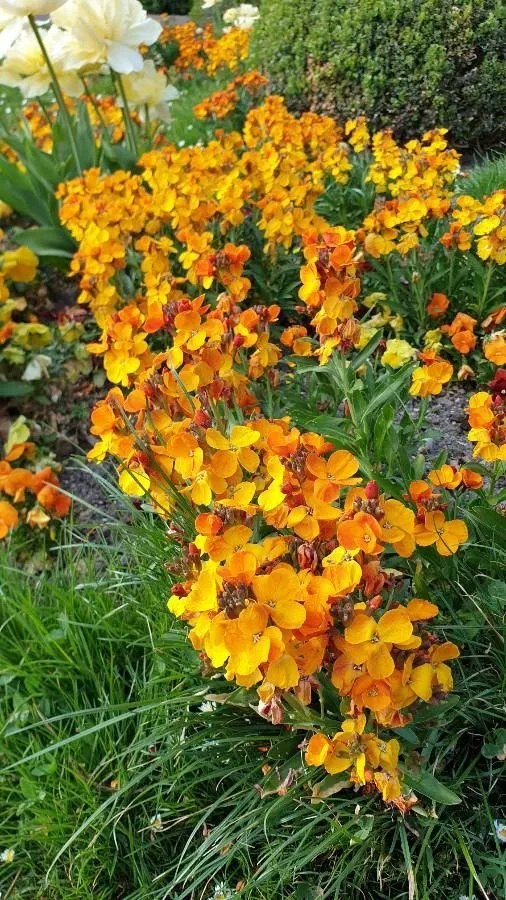
Author: Ehrh.
Bibliography: Beitr. Naturk. 7: 157 (1792)
Year: 1792
Status: accepted
Rank: species
Genus: Erysimum
Vegetable: False
Observations: C. Europe to Ukraine
The Smelly Wallflower, known scientifically as Erysimum odoratum, is a fascinating botanical species that hails from Central Europe and stretches its reach all the way to Ukraine. This remarkable flora belongs to the well-known family Brassicaceae, a diverse group that includes some of our most familiar vegetables.
Described by Ehrhart in 1792, Erysimum odoratum has held the interest of botanists and plant enthusiasts for centuries. Its distinctive presence is characterized by a particularly pungent aroma, which has been a defining feature and perhaps the inspiration behind its common name.
The Smelly Wallflower thrives in diverse environments ranging from woodlands to rocky regions, showcasing its impressive adaptability. Its flowers, which bloom in a variety of vibrant shades, contribute significantly to its attractiveness, despite the less appealing scent. This dichotomy makes the Erysimum odoratum a subject of both curiosity and study.
In terms of ecological contributions, the Smelly Wallflower plays an essential role within its native habitats. It provides nectar for pollinators, including bees and butterflies, supporting the intricate webs of food networks. Moreover, the plant often serves as a pioneer species, assisting in soil stabilization and paving the way for other plants to colonize areas.
While not commonly cultivated in gardens due to its strong odor, Erysimum odoratum remains an important species for naturalists and conservationists. Preservation efforts ensure that this unique member of the Brassicaceae family continues to thrive and maintain its place in the rich tapestry of our natural world.
In summary, the Smelly Wallflower or Erysimum odoratum is a notable species with a considerable historical background and ecological importance. Its intriguing combination of beauty and scent ensures its continued presence and study in the botanical community.
Eng: smelly wallflower
Deu: wohlriechender schöterich
Swe: kalkkårel
Nor: smallack, vilde leucojer, villack
En: Smelly wallflower
Bg: Благоуханна боянка
Zh: 星毛糖芥
Cs: Trýzel vonný
Nl: Welriekende steenraket
Fi: Tuoksu-ukonnauris
Fr: Vélar odorant
De: Duft-Schöterich, Wohlriechender Schöterich
Hu: Magyar repcsény
It: Violaciocca odorata
No: Smallack, Vilde leucojer, Villack
Fa: خاکشیر تلخ ادراتوم
Pl: Pszonak pannoński
Sv: Kalkkårel
Taken Jun 1, 2019 by Manu Pacha (cc-by-sa)
Taken Jun 15, 2019 by Manu Pacha (cc-by-sa)
Taken Jun 20, 2019 by Fejul Xeto (cc-by-sa)
Taken Jun 20, 2019 by Fejul Xeto (cc-by-sa)
Taken Jun 20, 2019 by Fejul Xeto (cc-by-sa)
Taken Apr 19, 2022 by Álvaro Del Risco (cc-by-sa)
Taken May 22, 2017 by Alexandre Leluault (cc-by-sa)
Taken May 7, 2021 by Sabin Poenariu (cc-by-sa)
Taken Jun 1, 2019 by Manu Pacha (cc-by-sa)
Taken Jun 15, 2019 by Manu Pacha (cc-by-sa)
Taken May 18, 2020 by Gaël Herve (cc-by-sa)
Taken May 13, 2020 by Kerstin Kerstin (cc-by-sa)
Taken May 18, 2018 by fayot (cc-by-sa)
Taken Jun 1, 2019 by Manu Pacha (cc-by-sa)
Taken Jun 15, 2019 by Manu Pacha (cc-by-sa)
Taken Apr 18, 2022 by Manuëlle (cc-by-sa)
Taken Jun 9, 2015 by Tela Botanica − George FOWLER (cc-by-sa)
Taken Apr 13, 2020 by Etienne GIRSCH (cc-by-sa)
Taken May 16, 2020 by André Hyvrier (cc-by-sa)
Taken May 18, 2020 by Gaël Herve (cc-by-sa)
Taken Jun 23, 2022 by Ana (cc-by-sa)
Taken Jul 1, 2020 by Nicolas Audegond (cc-by-sa)
Taken May 21, 2020 by grutz (cc-by-sa)
Taken Oct 24, 2022 by Tristan Jaton-Maria (cc-by-sa)
Taken May 25, 2021 by Hamid LATEB (cc-by-sa)
Taken Jul 15, 2005 by Photoflora – Benoit BOCK (©)
Taken May 8, 2022 by Eleanor Draper (cc-by-sa)
Taken Jul 20, 2020 by floris kluskabouter (cc-by-sa)
© copyright of the Board of Trustees of the Royal Botanic Gardens, Kew.
© copyright of the Board of Trustees of the Royal Botanic Gardens, Kew.
© copyright of the Board of Trustees of the Royal Botanic Gardens, Kew.
Growth habit>: Forb/herb
Family: Myrtaceae Author: (F.Muell.) K.D.Hill & L.A.S.Johnson Bibliography: Telopea 6: 402 (1995) Year: 1995 Status:…
Family: Rubiaceae Author: Pierre ex A.Froehner Bibliography: Notizbl. Bot. Gart. Berlin-Dahlem 1: 237 (1897) Year:…
Family: Sapindaceae Author: Koidz. Bibliography: J. Coll. Sci. Imp. Univ. Tokyo 32(1): 38 (1911) Year:…
Family: Asteraceae Author: A.Gray Bibliography: Pacif. Railr. Rep.: 107 (1857) Year: 1857 Status: accepted Rank:…
Family: Fabaceae Author: Medik. Bibliography: Vorles. Churpfälz. Phys.-Ökon. Ges. 2: 398 (1787) Year: 1787 Status:…
Family: Aspleniaceae Author: (Cav.) Alston Bibliography: Bull. Misc. Inform. Kew 1932: 309 (1932) Year: 1932…